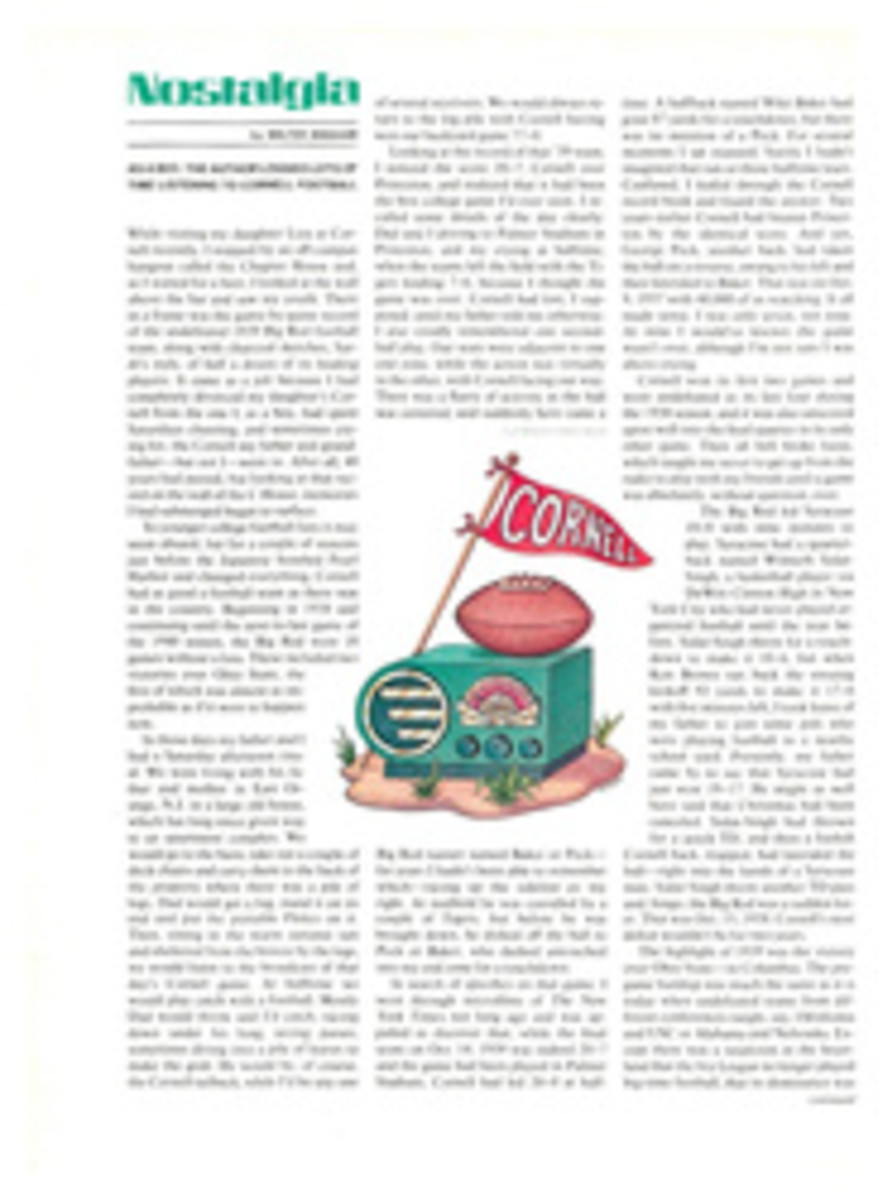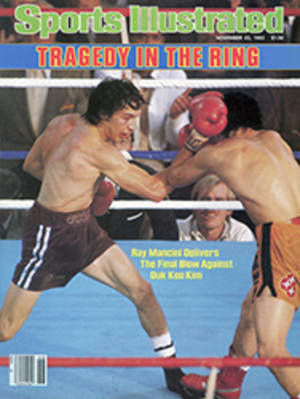
AS A BOY, THE AUTHOR LOGGED LOTS OF TIME LISTENING TO CORNELL FOOTBALL
While visiting my daughter Liza at Cornell recently, I stopped by an off-campus hangout called the Chapter House and, as I waited for a beer, I looked at the wall above the bar and saw my youth. There in a frame was the game-by-game record of the undefeated 1939 Big Red football team, along with charcoal sketches, Sardi's style, of half a dozen of its leading players. It came as a jolt because I had completely divorced my daughter's Cornell from the one I, as a boy, had spent Saturdays cheering, and sometimes crying for, the Cornell my father and grandfather—but not I—went to. After all, 40 years had passed, but looking at that record on the wall of the C House, memories I had submerged began to surface.
To younger college football fans it may seem absurd, but for a couple of seasons just before the Japanese bombed Pearl Harbor and changed everything, Cornell had as good a football team as there was in the country. Beginning in 1938 and continuing until the next-to-last game of the 1940 season, the Big Red went 18 games without a loss. These included two victories over Ohio State, the first of which was almost as improbable as if it were to happen now.
In those days my father and I had a Saturday afternoon ritual. We were living with his father and mother in East Orange, N.J. in a large old house, which has long since given way to an apartment complex. We would go to the barn, take out a couple of deck chairs and carry them to the back of the property where there was a pile of logs. Dad would get a log, stand it on its end and put the portable Philco on it. Then, sitting in the warm autumn sun and sheltered from the breeze by the logs, we would listen to the broadcast of that day's Cornell game. At halftime we would play catch with a football. Mostly Dad would throw and I'd catch, racing down under his long, arcing passes, sometimes diving into a pile of leaves to make the grab. He would be, of course, the Cornell tailback, while I'd be any one of several receivers. We would always return to the log pile with Cornell having won our backyard game 77-0.
Looking at the record of that '39 team, I noticed the score 20-7, Cornell over Princeton, and realized that it had been the first college game I'd ever seen. I recalled some details of the day clearly: Dad and I driving to Palmer Stadium in Princeton, and my crying at halftime, when the teams left the field with the Tigers leading 7-6, because I thought the game was over. Cornell had lost, I supposed, until my father told me otherwise. I also vividly remembered one second-half play. Our seats were adjacent to one end zone, while the action was virtually in the other, with Cornell facing our way. There was a flurry of activity as the ball was centered, and suddenly here came a Big Red runner named Baker or Peck—for years I hadn't been able to remember which—racing up the sideline to my right. At midfield he was corralled by a couple of Tigers, but before he was brought down, he dished off the ball to Peck or Baker, who dashed untouched into my end zone for a touchdown.
In search of specifics on that game, I went through microfilms of The New York Times not long ago and was appalled to discover that, while the final score on Oct. 14, 1939 was indeed 20-7 and the game had been played in Palmer Stadium, Cornell had led 20-0 at halftime. A halfback named Whit Baker had gone 87 yards for a touchdown, but there was no mention of a Peck. For several moments I sat stunned. Surely I hadn't imagined that run or those halftime tears. Confused, I leafed through the Cornell record book and found the answer. Two years earlier Cornell had beaten Princeton by the identical score. And yes, George Peck, another back, had taken the ball on a reverse, swung to his left and then lateraled to Baker. That was on Oct. 9, 1937 with 40,000 of us watching. It all made sense. I was only seven, not nine. At nine I would've known the game wasn't over, although I'm not sure I was above crying.
Cornell won its first two games and went undefeated in its last four during the 1938 season, and it was also unscored upon well into the final quarter in its only other game. Then all hell broke loose, which taught me never to get up from the radio to play with my friends until a game was absolutely, without question, over.
The Big Red led Syracuse 10-0 with nine minutes to play. Syracuse had a quarterback named Wilmeth Sidat-Singh, a basketball player via DeWitt Clinton High in New York City who had never played organized football until the year before. Sidat-Singh threw for a touchdown to make it 10-6, but when Ken Brown ran back the ensuing kickoff 92 yards to make it 17-6 with five minutes left, I took leave of my father to join some pals who were playing football in a nearby school yard. Presently, my father came by to say that Syracuse had just won 19-17. He might as well have said that Christmas had been canceled. Sidat-Singh had thrown for a quick TD, and then a foolish Cornell back, trapped, had lateraled the ball—right into the hands of a Syracuse man. Sidat-Singh threw another TD pass and, bingo, the Big Red was a sudden loser. That was Oct. 15, 1938. Cornell's next defeat wouldn't be for two years.
The highlight of 1939 was the victory over Ohio State—in Columbus. The pre-game buildup was much the same as it is today when undefeated teams from different conferences tangle, say, Oklahoma and USC or Alabama and Nebraska. Except there was a suspicion in the heartland that the Ivy League no longer played big-time football, that its dominance was over. The assumption was basically correct but, in this case, slightly premature.
To emphasize the confidence that he had in his team. Buckeye Coach Francis Schmidt skipped out the day before the game and went duck hunting. Three radio networks, as well as reporters from all over, were on hand to cover the game. Cornell alumni from the Midwest poured into Columbus. Ohio State took the opening kickoff and did exactly what you would expect it to do, even though this was 12 years before Woody Hayes arrived as coach. The Buckeyes went 86 yards in 19 plays, none of them passes, to lead 7-0. They then held the Big Red and marched 72 yards for a second touchdown to make the score 14-0 early in the second quarter.
Which is where I came in, sitting amid the logs in East Orange. I'm not sure why my father and I missed the first quarter, but I do recall that my despair over the score lasted only a few seconds—or until Walter Scholl broke off tackle and went 79 yards to make it 14-7. After that Cornell was a swarm of gnats attacking a water buffalo. At halftime I made several diving catches and, when play resumed, Cornell did too. The final score was 23-14.
This grand era of Cornell football ended with the penultimate game of 1940; it is a game that remains famous after all these years, though few fans recall that it broke a long winning streak. The Big Red, having ripped off six straight victories in '39, including a 21-7 triumph over Ohio State, had outscored its rivals 181-13. The game was played at Dartmouth on a drizzly afternoon in mid-November. Cornell was a heavy favorite over 3-4 Dartmouth, but the field was so slippery that neither team made much headway until Dartmouth returned a punt 50 yards early in the fourth quarter and kicked a field goal. With 2½ minutes remaining and the Big Red still behind 3-0, Cornell got the ball on its own 42 for what clearly would be its final chance.
I wasn't sitting by the woodpile for this one. I was in my grandfather's huge dark living room, my ear to a radio that stood about as high as a bureau. After a couple of completions as well as a pass interference call, Cornell was at the Dartmouth six. Three plays later the Big Red was on the one, but before the deciding play could take place, an official was walking the ball back to the six. Too many time-outs. A field goal seemed prudent, but Cornell went for the TD. Unfortunately, a pass was batted down in the end zone. Referee Red Friesell started to give the ball to Dartmouth, then ruled that Cornell had one more down. Dartmouth Captain Lou Young protested in vain to Friesell and with only three seconds left, a Big Red halfback named Bill Murphy made a leaping catch in the end zone of a pass from Scholl. In New Jersey, I leaped as high as Murphy.
The next morning the Times ran the headline: DISPUTED CORNELL PLAY TOPS DARTMOUTH, 7-3, AT FINISH. But unbeknown to me, a calm and gentlemanly investigation was taking place. No threats, no name-calling. Cornell President Edmund E. Day announced that "if the officials in charge of today's Dartmouth-Cornell game rule after investigation that there were five downs in the final series of plays, and that the winning touchdown was made on an illegal fifth down, the score of the game between Dartmouth and Cornell would be recorded as Dartmouth 3, Cornell 0." Dartmouth's Earl (Red) Blaik, soon to coach Doc Blanchard and Glenn Davis at Army, called Friesell "a great referee."
The possibility existed that the head linesman had ruled both teams offside on fourth down. But Head Linesman Joe McKenney hadn't made any such ruling, and Friesell admitted that, upon reviewing the press charts and film of the game, it was clear he alone had been in error.
Asa Bushnell, head of the Eastern Intercollegiate Football Association, said he was powerless to intercede. "Our association has no authority in the matter," he said, and Friesell said his own "jurisdiction ceased at the close of the game." Thus Cornell could have let the 7-3 result stand. But Cornell Athletic Director James Lynah issued a statement that "Cornell relinquishes claim to the victory and extends congratulations to Dartmouth." Dartmouth in turn praised Cornell for its sportsmanship and its winning streak.
Cornell lost a thriller to Penn the next week and the season was over. I suppose my father and I listened to the '41 games out by the log pile, but I don't remember, perhaps because the Big Red was only 5-3 that season. After that came the war, and when it was over, my grandparents were dead, we had moved from the house, and I had better things to do on Saturday afternoons in the fall. Just what they were I don't recall.
ILLUSTRATION
CHARLES WALLER

